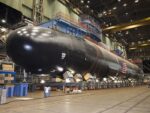Bangladesh has signed a landmark $2.2 billion agreement with China to acquire 20 Chengdu J-10CE multirole fighter jets. The deal marks the most significant airpower modernization effort in the history of the Bangladesh Air Force (BAF), signaling a strategic pivot toward advanced fourth-generation capabilities amid growing regional competition.
Strategic Leap for the Bangladesh Air Force
The J-10CE acquisition represents a major capability upgrade for the BAF, which currently operates aging fleets of MiG-29s and F-7MB/PGs. The J-10CE—an export variant of China’s advanced J-10C—is equipped with an Active Electronically Scanned Array (AESA) radar, modern datalinks, and compatibility with long-range Beyond Visual Range (BVR) missiles such as the PL-15 and PL-12.
This move aligns with Bangladesh’s Forces Goal 2030—a long-term military modernization roadmap focused on enhancing deterrence and operational readiness across all service branches. The J-10CEs are expected to replace older platforms while enabling greater interoperability with other modern systems acquired under recent defense procurements.
Deal Structure and Delivery Timeline
The $2.2 billion contract was reportedly signed between Bangladesh’s Directorate General of Defence Procurement (DGDP) and China National Aero-Technology Import & Export Corporation (CATIC), the designated exporter of Chinese aerospace systems. According to sources familiar with the deal—including regional defense outlets like Janes Defence Weekly and Global Times—the package includes aircraft, training simulators, ground support equipment (GSE), spare parts, weapons integration kits, and pilot training programs.
Deliveries are expected to begin in late 2026 or early 2027 following factory acceptance tests at Chengdu Aircraft Industry Group facilities in Sichuan Province. The first batch of pilots is already undergoing language instruction and technical familiarization in preparation for transition training in China.
Platform Capabilities: A Look at the J-10CE
The J-10CE is an export-configured version of the People’s Liberation Army Air Force’s (PLAAF) J-10C multirole fighter developed by Chengdu Aircraft Corporation. It features:
- AESA radar system—reportedly KLJ-7A or similar class—offering high-resolution tracking and electronic counter-countermeasures (ECCM).
- Compatibility with PL-series air-to-air missiles including:
- PL-15 BVR missile (~200 km range)
- PL-12 medium-range active radar-guided missile
- PL-8/PL-10 short-range infrared-guided missiles
- Glass cockpit with multifunction displays (MFDs), hands-on throttle-and-stick (HOTAS) controls.
- Datalink integration for network-centric operations.
The aircraft is powered by a single WS-10B turbofan engine offering improved thrust over earlier Russian AL-31FN powerplants used on previous variants. While not stealthy by design, its reduced radar cross-section compared to legacy platforms enhances survivability against older SAM systems prevalent in South Asia.
Regional Implications and Strategic Signaling
The acquisition positions Bangladesh as only the second known export customer for the J-10CE after Pakistan—which inducted its first squadron of these fighters into service in March 2022 under Project AZM. For Dhaka, this move signals both growing confidence in Chinese defense technology and a desire to assert greater control over its airspace amid increased aerial activity from neighboring countries including India and Myanmar.
India operates more advanced platforms such as Su-30MKIs and Rafales but has also faced challenges maintaining fleet availability due to spares shortages and maintenance cycles. The introduction of AESA-equipped fighters into BAF inventory may not tilt regional balance but does raise operational thresholds significantly compared to legacy MiG/F-series jets operated previously by Dhaka.
China’s Expanding Footprint via Defense Exports
This deal further cements China’s role as a key defense supplier across South Asia following similar exports to Pakistan (JF-17/JF17B & HQ-series SAMs), Sri Lanka (Type 053H frigates), Nepal (light armored vehicles), and Myanmar (K8W trainers). The affordability of Chinese platforms—coupled with rapid delivery timelines—continues to make them attractive alternatives for developing nations seeking quick capability boosts without Western conditionalities.
Caveats Around Technology Transfer & Autonomy
No details have emerged regarding local assembly or technology transfer components within this contract—a common limitation associated with Chinese turnkey deals versus Western offset-based models. This could constrain indigenous sustainment capacity unless future agreements include licensed MRO or depot-level support infrastructure within Bangladesh itself.
Comparative Analysis: Why Not Western Fighters?
The selection of the J-10CE also reflects geopolitical considerations beyond pure performance metrics. Previous attempts by Dhaka to procure Western aircraft—including surplus F‑16s from U.S.-aligned sources or Eurofighter Typhoons from Italy—have been stymied by cost concerns or political hesitations around end-user monitoring clauses imposed by NATO suppliers.
The Chinese offer reportedly included favorable financing terms via state-backed loans through China Exim Bank along with expedited delivery windows—a combination difficult to match by Western OEMs constrained by parliamentary oversight or export control regimes like ITAR.
Avoiding Sanctions Risk?
Bilateral ties between Dhaka and Beijing have remained stable despite global scrutiny over China’s military-industrial exports. Unlike India’s S‑400 purchase from Russia—which triggered CAATSA-related concerns—the Sino-Bangladeshi defense relationship has so far avoided U.S.-led sanctions pressure due largely to Bangladesh’s non-aligned foreign policy stance.
What Comes Next? Integration Challenges Ahead
The success of this program will depend heavily on how well BAF can integrate these new fighters into its existing command-and-control architecture while ensuring pilot proficiency through sustained training cycles. Questions remain about:
- Sustainment logistics given dependency on Chinese supply chains;
- Tactical doctrine evolution around AESA/BVR combat;
- C4ISR integration across legacy Russian-origin assets;
- Munitions stockpile adequacy during high-tempo operations;
If managed effectively—with potential future upgrades such as EW pods or targeting pods—the J‑10CE fleet could become a cornerstone of Bangladesh’s air deterrence posture well into the mid‑2030s.
A Broader Trend Among Mid-Tier Air Forces?
The move mirrors broader trends among mid-tier air forces globally seeking affordable fourth-generation+ fighters without entering high-cost fifth-gen programs like F‑35 or Su‑57 that demand extensive infrastructure upgrades and interoperability constraints. With Egypt acquiring Rafales, Indonesia pursuing KF‑21 Boramae co-development with South Korea—and now Bangladesh opting for Chinese designs—the global fighter market continues fragmenting along political-economic lines rather than purely technical ones.









